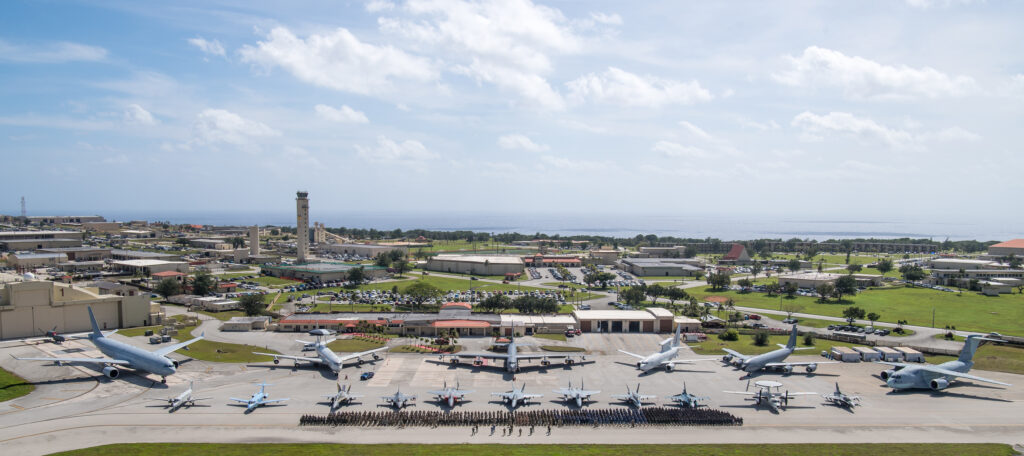
U.S. Military, Royal Australian Air Force, and Japan Air Self-Defense Force stand together at start of Exercise Cope North 20 (CN20), at Andersen AFB, Guam in Feb. 2020.
WASHINGTON: The US, Japan and Australia will test their ability to work together, especially in keeping supplies moving while under attack, during Cope North 2021 in two weeks.
During the exercise, the U.S. Air Force will focus on its Agile Combat Employment (ACE) concept, says Brig. Gen. Jeremy Sloane, who commands the 36th Air Wing at Andersen AFB in Guam. The annual Cope North exercise includes the US Air Force, the Royal Australian Air Force and the Japanese Self Defense Forces. In 2020 the exercise, included roughly 2,500 participants, Sloane said, and nearly 100 aircraft.
The ACE concept is the Air Force’s effort to figure out how to overcome expected attacks on supply chains, depots and bases, known as ‘logistics under attack,’ in a conflict with China or Russia. Logistics under attack — ‘contested logistics,’ is one of the sub-elements of the US military’s developing Joint Warfighting Concept for prosecuting operations simultaneously and seamlessly across the air, land, sea, space and cyberspace domains.
Sloane said that the upcoming Cope North will involve “one of the most challenging ACE operations” exercises, when “F-35s and F-16s will conduct ‘spoke’ operations by landing, refueling, replanting and launching at Andersen’s that Northwest Field. And, for those of you haven’t been here, Northwest Field is a truly austere airfield carved out of the jungle on the northwest side of our base. Just under 8000 feet — with some ramp space, taxiways and some hangar capacity — Northwest Field is surrounded by harsh jungle. It has minimal markings, minimal lighting, and no permanent aircraft or airfields control. Thus far only C-130 and helo ops have been conducted on that airfield.”
Sloan said the 36th Air Wing’s Contingency Response Group “will practice opening the airfield, controlling the airspace, clearing landing options, [and] supporting combat turns of F-35s and F-16s” during the exercise.
In a peer conflict with China, Andersen has become “a big option to support operational plans and becomes an even bigger target,” Sloane said. This includes everything from “designing and executing a new support contract for vehicle maintenance, to rewriting our joint memorandum of agreement with the Navy and Marine Corps, to gaining fiscal control and operational flexibility over supply, lodging services, maintenance, etc.,” he said. It also includes “upgrading and proving comms infrastructure to enable future exercises or operational concepts.”
Air Force Chief of Staff Gen. CQ Brown has identified “agility, posture protection and JADC2 [Joint All Domain Command and Control] as “the key capabilities that enable ACE.”
Among the efforts to do that was the Valiant Shield exercise held in September, Sloane said. While 2020 Valiant Shield was “scaled down by 50 percent” due to the COVID-19 pandemic, it involved some 1,100 personnel and 37 aircraft — B-1 bombers, KC–135 and KC-10 tankers, F-16 and F-22 fighters, EC-130 and C-130J transports, Airborne Warning and Control (AWACS) planes, and MQ-4 surveillance drones. For ACE operations, the exercise demonstrated “unconventional” re-fueling operations from an austere location, including re-fueling an F-22 from the C-130J using the new(ish) Aerial Bulk Fuel Delivery System (ABFDS), and the aircraft’s first “hot refueling from a C-130J,” Sloane said.
The ABFDS comprises two 3,000 gallon “aerial fuel bladder” tanks, two pumping modules and hoses, according to a Pacific Air Forces press release. The Valiant Shield refueling of the F-22 using ABFDS was the first time the system was used for a “hot pit” refuel a fifth-generation fighter, the release explained.
The exercise also demonstrated some aspects of the Advanced Battle Management System (ABMS), the Air Force’s part of JADC2 — although not to the extent that the Air Force had hoped due to the COVID restrictions.
Northrop sees F-16 IVEWS, IBCS as ‘multibillion dollar’ international sales drivers
In addition, CEO Kathy Warden says the company sees a chance to sell up to five Triton UAVs to the NATO alliance.


























